Four outstanding researchers at the U.S. Department of Energy’s Fermi National Accelerator Laboratory were presented 2025 Universities Research Association Honorary Awards during a ceremony at Fermilab earlier this year. URA is a consortium of over 90 leading research-oriented universities, primarily in the United States, and also in Italy and the United Kingdom.
“This year’s awardees remind us that science thrives when brilliant minds come together with persistence and purpose, laying the groundwork for future generations.”
John Mester, URA President and CEO
“Each of these awards tells a story of discovery, commitment and collaboration,” said John Mester, URA President and CEO. “Celebrating researchers at every career stage honors their extraordinary contributions to Fermilab’s mission and highlights their essential role in advancing U.S. scientific leadership. This year’s awardees remind us that science thrives when brilliant minds come together with persistence and purpose, laying the groundwork for future generations.”
Doctoral Thesis Award — Gray Putnam
The URA Honorary Doctoral Thesis Award was presented to Gray Putnam, a Lederman Science Fellow at Fermilab, whose dissertation described the data taking, processing, calibration and analysis that led to the first complete physics result of the ICARUS experiment at Fermilab.

As part of Fermilab’s Short-Baseline Neutrino program, ICARUS is a liquid-argon time projection chamber, or LArTPC, that detects neutrinos produced by the Fermilab accelerator complex. LArTPCs consist of a tank of liquid argon containing a high-voltage cathode plane across from a set of anode detector planes. Charged particles traveling through the liquid argon ionize argon atoms, liberating electrons, and an electric field applied to the system causes these electrons to drift toward the anode planes.
“We detect those ionization electrons, and that detection forms the actual image,” said Putnam. “They’re wonderfully visual. That’s my favorite thing about working with this technology — you can actually see everything that the particles do, which is rare in particle physics.”
As a graduate student at the University of Chicago, Putnam helped calibrate ICARUS by refining the LArTPC, likening it to correcting lens distortion in a camera. Just as a camera’s lens alters how objects appear, Putnam explained, the way ionization signals are detected in a LArTPC can distort particle tracks.
Initially, there was a mismatch between simulated and real data in ICARUS, leading to an incorrect representation of the detector’s behavior. So, Putnam developed a tuning procedure to address this, and the real data and simulations came back into alignment. With the detector properly calibrated, the entire physics program for ICARUS was enabled.
In the award citation, URA specifically praised Putnam’s “pioneering work to understand and quantify novel effects” in LArTPCs, which will be vital for current and future experiments.
Early Career Award — James Mott
Fermilab scientist James Mott received this year’s URA Honorary Early Career Award “for his leadership and scientific contributions to the Muon g-2 experiment,” one of Fermilab’s most notable particle physics experiments.

Muon g-2 measured the wobble of a subatomic particle called the muon, which is similar to the electron but about 200 times its mass. Theoretical physicists created predictions of its wobble, known as the magnetic moment of the muon, and experimental physicists made measurements to test if the values agreed.
In June, the Muon g-2 collaboration published their third and final measurement of the magnetic moment, which agreed with their previous measurements and surpassed their targeted precision.
Mott began working on Muon g-2 when he became a postdoctoral researcher at Boston University in 2014. At that time, Muon g-2 at Fermilab was ramping up, and Mott was in an ideal place to jump onboard.
Mott ended up leading the design effort for electronics for the experiment’s tracker system. He stayed involved for its prototyping, installation, commissioning and operation. As the tracker installation began in 2016, Mott became based at Fermilab full time.
By the time Muon g-2 started taking data in 2018, Mott had built up vast knowledge in different areas of the experiment. During the first physics data-taking run, Run 1, he participated in the analyses of the data and assisted with corrections to the beam dynamics. “I kind of dipped my toe in quite a lot of different analysis areas,” he said. In 2020, Mott officially joined Fermilab as a Wilson Fellow.
For Runs 2 and 3 of the experiment, Mott was the analysis coordinator. “The second unblinding, for me personally, was really important,” he said. “That was my baby. The relief when that one agreed with our previous result was really powerful.”
That leadership during Runs 2 and 3, as well as his contributions to beam dynamics corrections, earned Mott the URA Honorary Early Career Award.
Today, Mott continues contributing as a reviewer for the collaboration’s next analysis and is transitioning to another muon experiment at Fermilab — Mu2e — ensuring lessons from Muon g-2 are passed along.
Tollestrup Award for Postdoctoral Research — Lauren Yates
Lauren Yates, a newly minted assistant professor at the University of Notre Dame, received the 2025 URA Honorary Tollestrup Award for Postdoctoral Research for her work on the Short-Baseline Near Detector, or SBND.
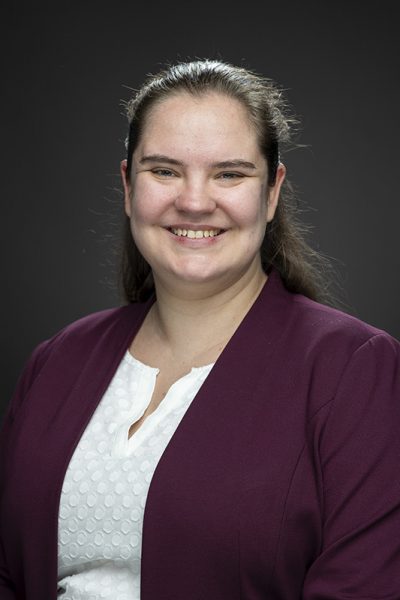
Yates completed her doctoral research on MicroBooNE, part of the trio of detectors in Fermilab’s Short-Baseline Neutrino Program along with ICARUS and SBND. She said she was happy to participate in MicroBooNE’s data analyses but wanted a chance to help build a detector from the ground up. So when it was time for her postdoctoral research at Fermilab, Yates leapt at the chance to join SBND, bringing lessons learned from MicroBooNE to the commissioning of this new detector.
Like ICARUS, the Short-Baseline Near Detector is a liquid-argon time projection chamber: a tank of liquid argon with a high voltage that causes ionized electrons to drift toward the detection plane. SBND requires 100 kilovolts — the equivalent voltage of approximately 8,000 car batteries.
“The whole detector is inside the cryostat, but you can’t put your high-voltage power supply inside the cryostat,” said Yates.
To get the high voltage from the outside power supply into the detector, physicists needed a piece of equipment called a high-voltage feed-through. Yates said it took several months of testing feed-throughs before they finally found one that worked. The day they got the cathode to 100 kilovolts for the first time is one of Yates’s favorite memories from SBND.
At the same time the feed-throughs were being tested, Yates was coordinating SBND’s commissioning. She compared a detector’s commissioning to turning on a car for the first time — except it’s a brand new, one-of-a-kind car that was assembled from scratch and built with parts fabricated by many teams working separately.
“Watching the car just mosey down the driveway for the first time is very exciting,” said Yates. “We got to watch it go from that to doing 60 on the highway with confidence.”
In all, it took nine months to commission SBND. Yates pointed out they had a relatively large team, with up to 50 people contributing much of their time at the busiest point.
“There’s half a dozen or so different subsystems of the detector. For the detector to really, truly fully work, they all have to be coordinated, and they all independently have to achieve certain milestones,” said Yates. “Then everything has to work together to achieve other milestones.”
For her contributions to SBND’s high-voltage system and her leadership of the SBND detector commissioning, Yates received this year’s Tollestrup Award. “I was stunned in the end at how everyone worked so hard, and things really worked out, even though there were serious challenges,” she said.
Engineering Award — Chris Jensen
Chris Jensen began his long career at Fermilab in January 1990 in the same group he is part of today: the Power Electronics Systems Department within the Accelerator Directorate. His first task at Fermilab was to design a pulse-power system for the Main Injector beamline. With a pulse-power system, energy is accumulated and stored over a long period of time and then delivered in short bursts. One use of pulse power in particle accelerators is to transfer particles from one accelerator to another.
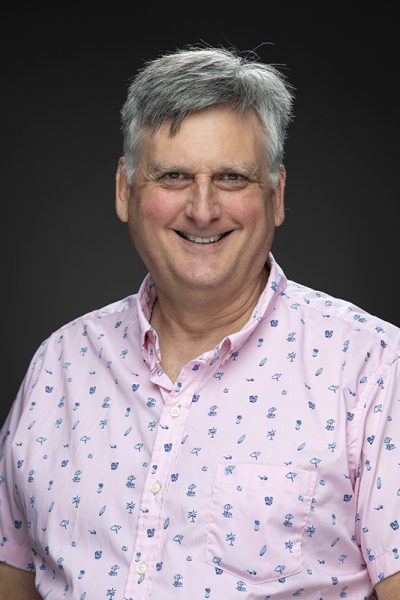
For his first 25 years at Fermilab, Jensen worked on everything pulse-power. He designed systems for the Fermilab’s powerful Tevatron accelerator and the European X-Ray Free-Electron Laser Facility in Germany.
Then, in 2016, Jensen was appointed director of the Power Electronics Systems Department. At the time, his group was working on the horn power supply for the Long Baseline Neutrino Facility, or LBNF. When some colleagues retired, Jensen took over as lead engineer of the project, drawing on his experience from working on the Neutrinos at the Main Injector, or NuMI, and the Booster Neutrino Beam horn power supplies.
The LBNF horn system is a series of pulsed magnetic devices that will focus the beam of secondary particles that make neutrinos. Without the horns, LBNF would generate way fewer neutrinos for the Deep Underground Neutrino Experiment. So, ensuring the power supply is robust and reliable is necessary for the success of Fermilab’s flagship experiment.
Because the Long Baseline Neutrino Facility horn system is designed to last 30 years, it must be tested thoroughly. Once installed and operational, accessing and repairing the system is neither easy nor practical. And if a faulty power supply caused any of the horns to fail, it would take a long time to replace them. Jensen and his team have been testing the power supply prototype over the last year, identifying and fixing the parts that need attention. They are now in production for a power supply to test individual LBNF horns before they are installed in the final system.
“This is really the culmination of years of work,” said Jensen. “Design started at least 10 years ago, and now it’s finally coming to fruition. The hard part is not the design, it’s making it work.”
Jensen has been in the Power Electronics Systems Department — though the group’s name has evolved over the years — for his entire Fermilab career. Two years ago, he became deputy department head, and he is now looking forward to letting others lead new projects.
This year’s URA Honorary Engineering Award recognizes his “invaluable three-and-a-half-decade career as an expert in power electronics systems, culminating in his recent groundbreaking work proving a prototype power supply for the LBNF Horn Focusing System, a critical achievement for the DUNE experiment.”
“It’s really been a group effort, said Jensen. “I owe a lot of thanks to a lot of people. I received the award, but there have been a whole lot of people contributing.”
Fermi National Accelerator Laboratory is America’s premier national laboratory for particle physics and accelerator research. Fermi Forward Discovery Group manages Fermilab for the U.S. Department of Energy Office of Science. Visit Fermilab’s website at www.fnal.gov and follow us on social media.
The U.S. Department of Energy’s Fermi National Accelerator Laboratory is not only one of the world’s premier particle physics and accelerator research facilities but also a key innovation hub for DOE in its goals of advancing cutting-edge fields that include quantum information science and artificial intelligence. Over the course of this year, Fermilab’s dedicated team of scientists, engineers, technicians and operations staff advanced the lab’s scientific mission through impactful new results, exciting collaborations and progress on essential projects that support its future as the neutrino research capital of the world.
Building the neutrino capital of the world
Fermilab is the host laboratory for the Deep Underground Neutrino Experiment, the largest neutrino experiment ever undertaken. The DUNE collaboration has grown to more than 1,500 collaborators from more than 35 countries and seeks to answer some of the biggest questions about our universe by studying elusive particles called neutrinos. The DUNE far detectors will be installed in the Long-Baseline Neutrino Facility a mile underground in new, massive caverns recently excavated in Lead, South Dakota, at the Sanford Underground Research Facility. With excavation finished, 2025 work centered on outfitting the underground research space with essential infrastructure such as power and utilities. This year, more than 3,000 tons of steel for DUNE’s far detectors arrived in South Dakota. An in-kind contribution from CERN, the steel will form the structures for the experiment’s cryostat modules that will house the far detectors, each measuring 216 feet long, 62 feet wide and 60 feet high.
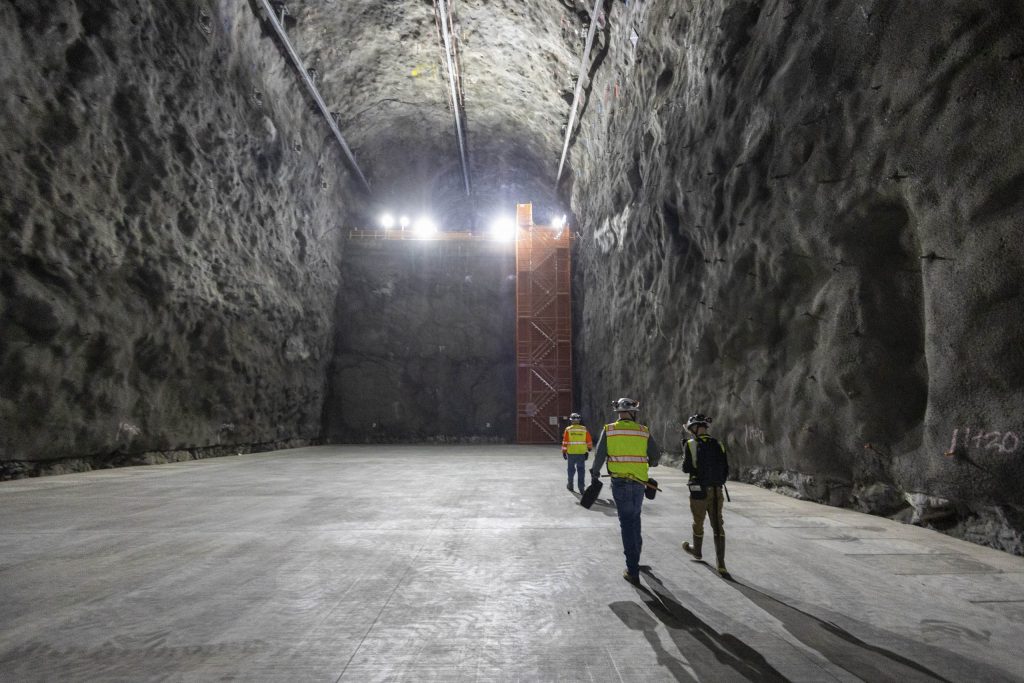
The powerful neutrino beam for DUNE will be generated by a new 215-meter-long linear particle accelerator, which is currently being built at Fermilab by the Proton Improvement Plan-II project. Construction at the PIP-II site made important progress, and in January 2025, an essential piece of equipment, the PIP-II coldbox, arrived at Fermilab after a two-month voyage from France. It is now installed in the Cryogenic Plant Building on the PIP-II site in Batavia.
In October, the PIP-II collaboration received authorization for use and possession of the High-Bay Building, part of the in-progress Linac Complex. This allows the collaboration to begin installing accelerator components and support equipment, first focusing on components previously installed in the PIP-II Injector Test Facility. Soon, they will take on management of the linac tunnel, which will allow them to continue installing technical components like the cryogenic transfer line, radiofrequency waveguides and related infrastructure.
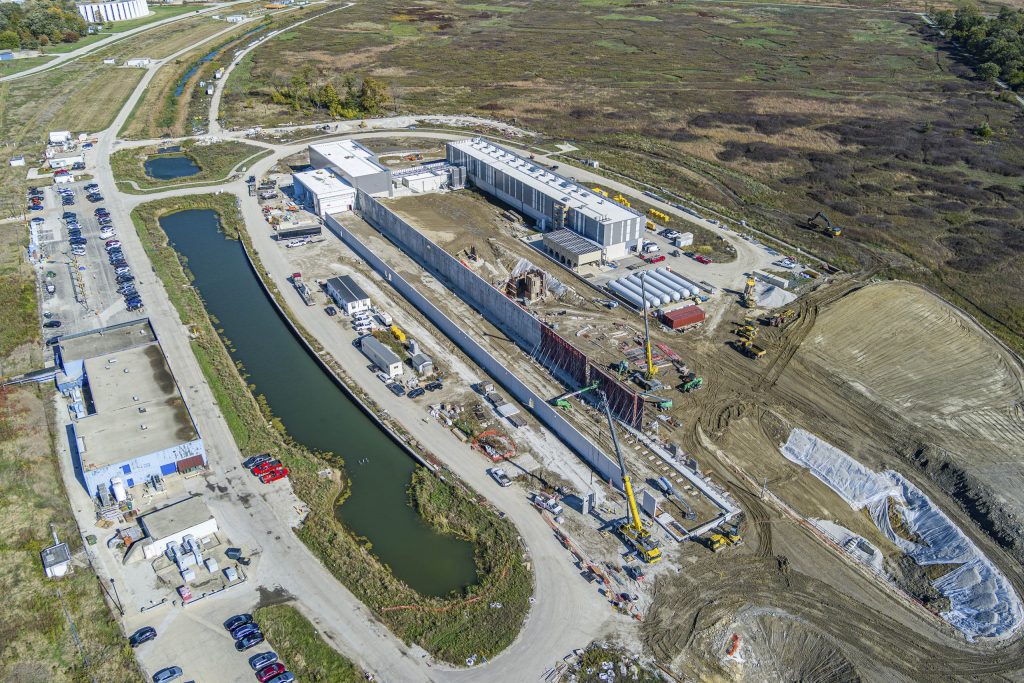
Producing exciting new results on the Intensity Frontier
In 2025, Fermilab researchers presented impactful new science results, and their work was published in more than 540 scientific papers in highly respected journals. As a vivid example of Fermilab’s scientific leadership, this year brought the long-awaited third and final measurement of the muon magnetic anomaly by the Fermilab Muon g-2 collaboration. Released in June, the result agrees with their published results from 2021 and 2023 but with a much better precision of 127 parts per billion, making it the world’s most precise measurement of the muon magnetic anomaly. While there are still disagreements about the predicted value among theorists, this experimental measurement is a tremendous achievement of precision. It also marks an end to the Muon g-2 experiment’s main analysis — though scientists will perform more analyses with the data, including measuring a property of the muon called the electric dipole moment and testing a fundamental property of physical laws known as charge, parity and time-reversal symmetry.
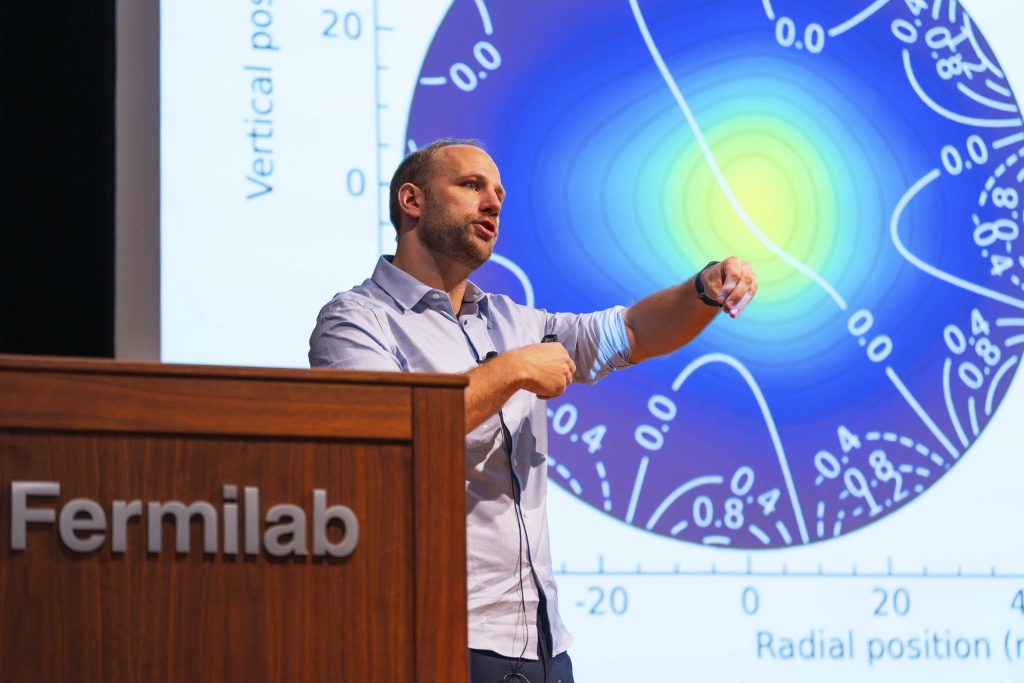
Along with the Muon g-2 results, Fermilab advanced a variety of particle physics research initiatives this year. Fermilab’s Short-Baseline Neutrino Program consists of three liquid-argon time projection chamber experiments — SBND, MicroBooNE and ICARUS — that use the Booster Neutrino Beam to study neutrino oscillation. SBND, the Short-Baseline Near Detector, now beginning its second year of operation, sees about 7,000 neutrinos per day — the largest sample of neutrino interactions in liquid argon in the world. The collaboration presented some of their initial data this year, and they aim to publish their first cross-section measurement in 2026.
MicroBooNE has been working to find evidence for a fourth neutrino — the sterile neutrino, which could explain anomalous behavior observed by prior experiments. Shortly after celebrating the 10th anniversary of its start of operations, MicroBooNE published a new result in Nature on Dec. 3 that ruled out the possibility of a single sterile neutrino with 95% certainty. This achievement may compel physicists to look elsewhere to solve one of the neutrinos’ many mysteries.
The far detector for the SBN Program, ICARUS, celebrated five continuous years of data collection. Over the past year, the collaboration published and produced various analyses about physics beyond the Standard Model, dark matter candidates, neutrino cross-sections, the performance of the detector, and more.
All three detectors contribute to the development of particle detection technology for DUNE, and in 2025, the Booster Neutrino Beam itself achieved record-breaking beam delivery.
Elsewhere on the Fermilab site and beyond, the NuMI Off-axis νe Appearance experiment, or NOvA, is a long-baseline neutrino experiment studying a phenomenon called neutrino oscillation. In October, the NOvA collaboration published joint results with Japan’s T2K collaboration in Nature. This initial analysis provides some of the most precise neutrino-oscillation measurements in the field, adding to physicists’ knowledge about the particles and paving the way for DUNE and other future and current neutrino experiments.
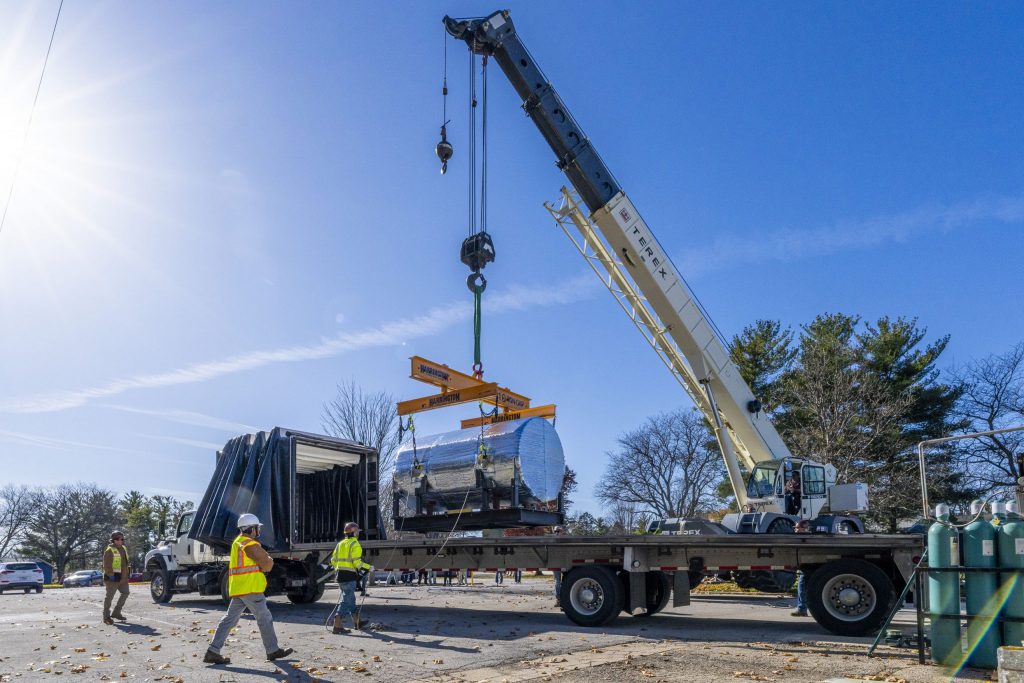
In November, researchers at Fermilab moved the final subdetector for the Mu2e experiment into the experiment hall, marking a major step forward for the collaboration. Once completed, Mu2e will search for a rare muon conversion that may unlock evidence of physics beyond the Standard Model.
Advancing the Energy Frontier on an international scale
As the host institution for U.S. scientists working on the CMS experiment at the CERN international particle physics laboratory, Fermilab had the opportunity to contribute to another record-breaking year for CERN’s Large Hadron Collider, the most powerful particle accelerator in the world.
This year, CMS recorded a total integrated luminosity — the number of particles colliding in an area at a time — of nearly 500 inverse femtobarns, far surpassing expectations. Fermilab’s CMS team was essential to enabling the recording of this data. The CMS collaboration produced an updated suite of the most precise measurement of the Higgs boson’s properties and new limits on its self-coupling. The LHC is undergoing a major upgrade to become the High-Luminosity Large Hadron Collider. Several components for this are being developed, assembled and tested by the HL-LHC Accelerator Upgrade Project, a consortium of U.S. national laboratories and institutions that includes Brookhaven National Laboratory, Lawrence Berkeley National Laboratory and Fermilab. Among the components are four quadrupole accelerator magnets that Fermilab shipped to CERN earlier this year. These quadrupoles weigh 25 tons each and contain everything needed to focus the proton beams that will pass through their cores.
Making strides toward solving mysteries of the universe
Fermilab has eyes on the skies with DESI, the Dark Energy Spectroscopic Instrument, an international experiment managed by Lawrence Berkeley National Laboratory. Fermilab contributed key components to DESI, aiding in the exploration of the far reaches of the universe. In 2025, the DESI collaboration published new results and released the largest 3D map of the universe yet. The results found that combining the DESI data with other experiments shows signs that the impact of dark energy may be weakening over time — and the model of how the universe works may need an update.
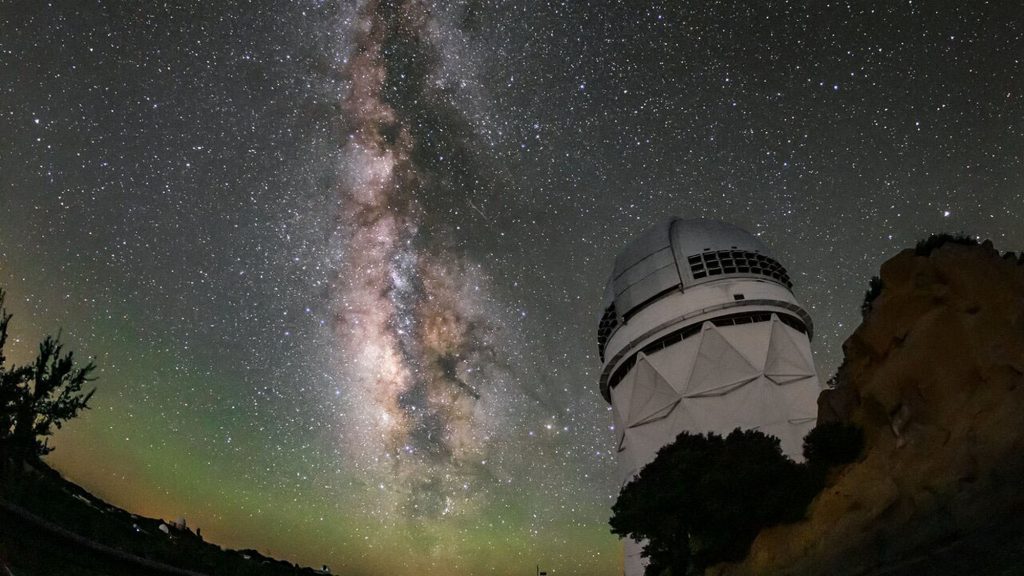
Meanwhile, in October, data from the Fermilab-led Dark Energy Survey found that the current model of the universe is still the best description of what we observe. The new results were from a study led by University of Chicago scientists in which they cataloged the universe by mapping huge clusters of galaxies. The DES collaboration expects to announce updated cosmology results early in 2026.
Recently, Fermilab scientists finished installing the dark-matter experiment SuperCDMS at SNOLAB, a 6,000-square-yard underground space in an active nickel mine in Sudbury, Canada. Hosted by SLAC National Laboratory, SuperCDMS has more than 100 members from 25 institutions in North America, Europe and Asia. After they finish this current period of cooling and testing, the collaboration aims to start collecting data in early 2026.
Fermilab also completed construction of its laser laboratory for the world’s largest vertical atom interferometer, called MAGIS-100. With the goal of discovering new physics, the research space will house state-of-the-art lasers for a quantum sensing device capable of seeing the tiniest signals emanating from the farthest reaches of the universe.
Leading the way in quantum and AI research
Fermilab is the home of the Superconducting Quantum Materials and Systems Center, one of five research centers DOE funds as part of a national initiative to develop and deploy the world’s most powerful quantum computers and sensors. In November, DOE renewed SQMS funding for another five years — a momentous achievement for the center and for Fermilab.
SQMS made important research contributions in its fifth year. These achievements included groundbreaking demonstrations of superconducting coupled systems with impressively longer lifetimes that open the path to more powerful qudit-based quantum computers; advancing the understanding of defects and disorder that lead to variations in the performance of quantum devices; new approaches for quantum arithmetic that could facilitate the use of quantum computers in medicine; and new methods for experimental modeling that result in improved limits on the question of quantum mechanics behaving nonlinearly.
In December, Fermilab and SQMS hosted Exploring the Quantum Universe – a Fermilab Quantum Symposium. The event attracted over 600 attendees representing more than 100 different organizations. The two-day event brought together leaders from across the global quantum community to reflect on recent progress and outline next steps for the field.
Since 2020, SQMS researchers have produced 306 publications and 10 patent applications. SQMS now has 43 collaborating institutions, including new industrial partners.
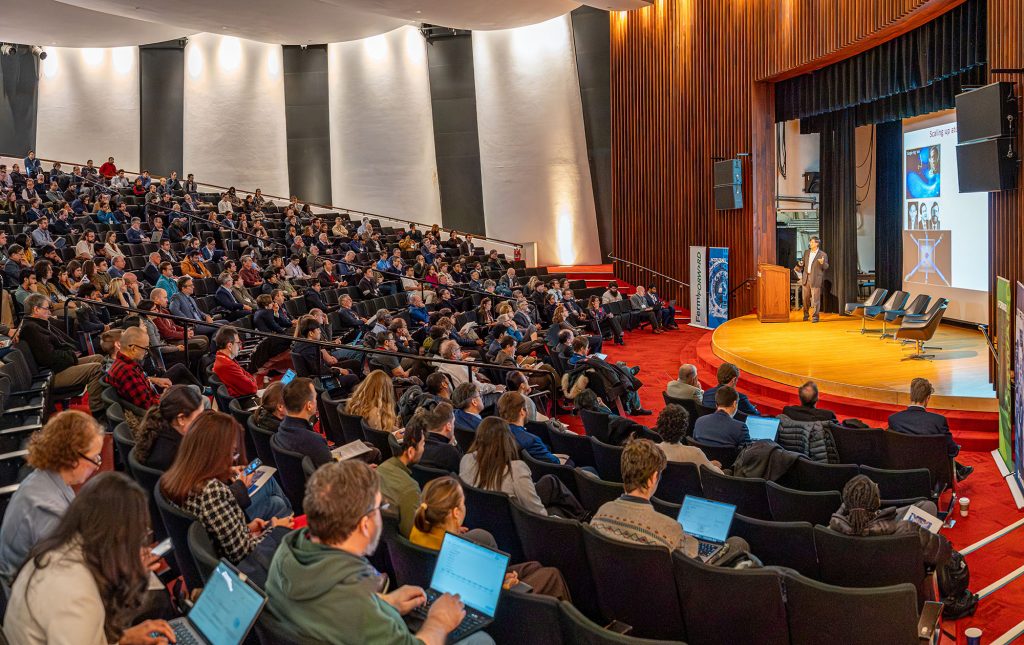
Fermilab is involved in more quantum research beyond SQMS. At Fermilab’s NEXUS laboratory — the Northwestern Experimental Underground Site — researchers measured correlated charge noise in superconducting qubits underground for the first time. Their results, published in Nature in November, will inform future dark matter detection research and provide invaluable insights into how to optimize quantum sensors by reducing background noise.
To harness the power of artificial intelligence and ensure that AI advances are incorporated efficiently, Fermilab inaugurated the AI Coordination Office. This cross‑laboratory team serves as the central hub for strategic planning, mapping AI opportunities to scientific and operational priorities while aligning them with DOE’s objectives. It also aims to bring state-of-the-art tools to Fermilab staff and tailor them for high-energy physics‑specific use cases.
In November, DOE announced the Genesis Mission, an initiative that links the national laboratories with industry and academia to harness frontier AI and quantum science. Fermilab is primed to play an important role, both as a creator of cutting‑edge AI methods and as a steward of the high‑energy physics mission.
And Fermilab is already leveraging artificial intelligence to drive greater efficiency and productivity across both scientific research and day-to-day operations. Fermilab delivered a number of high‑impact AI achievements, including tools and techniques for intelligent sensing, AI-ready datasets for particle collision data, AI tools for accelerator operations, new ML-accelerated models to speed up simulations of CMS and accelerator systems, and more.
In 2025, the lab continued participation in the Tachyon Project, which will model the entire distributed infrastructure required to transmit and analyze data from DUNE to the computing facilities at Fermilab and Argonne National Laboratory in near real-time. The goal is to develop end-to-end models, using artificial intelligence and machine learning techniques, of the data paths used by current neutrino experiments and apply those models to develop data paths and workflows for DUNE.
Making breakthroughs in emerging technologies
In November, DOE announced a partnership between Fermilab and the company Qblox, under which Qblox will coordinate manufacturing, distribution and support for the Quantum Instrumentation Control Kit, or QICK, to advance U.S. quantum research and workforce development. Originally developed at Fermilab, QICK is an open-source platform for managing quantum readouts and controls. It plays a critical role in synchronizing quantum processors and sensors, making it a foundational technology for the growing quantum ecosystem.
Also in November, Fermilab installed a major piece of a new facility called MAGNet Environment Simulator, or MAGNES, that can support efforts to harness fusion energy. MAGNES will test superconducting cables that could be used for a future fusion reactor, which, when cooled to extremely low temperatures, lose all electrical resistance and can carry very high currents essential for generating powerful magnetic fields. The facility’s fundamental magnet research will produce valuable insights into the electromagnetic and mechanical properties of superconducting magnets, advancing government, international and private fusion energy projects alike. Scientists expect MAGNES to become operational within the next few years.
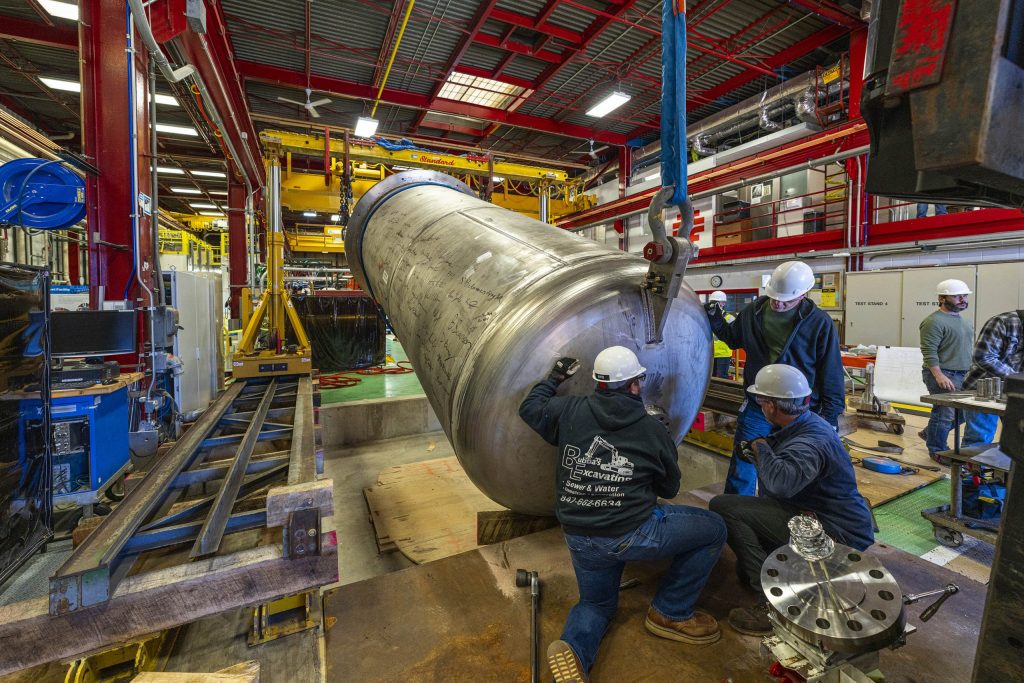
Honoring Fermilab’s past, inspiring the future
Fermilab closed out 2025 with a ceremony to officially name the Integrated Engineering Research Center in honor of the late Helen Edwards, a legendary physicist at Fermilab who oversaw construction of the Tevatron particle accelerator. The newly-named Helen Edwards Engineering Research Center is an 80,000-square-foot, multistory laboratory and office building adjacent to Fermilab’s iconic Wilson Hall. The new space is a collaborative laboratory where engineers, scientists and technicians tackle the technical challenges of particle physics and pioneer groundbreaking technologies.
Fermilab’s achievements reflect the lab’s enduring commitment to discovery, technological innovation and service to the scientific community. From advancing next-generation accelerators and quantum technologies to delivering groundbreaking physics results and pioneering AI and machine learning research, Fermilab continues to push the boundaries of knowledge and strengthen the foundation for the discoveries of tomorrow.
Fermi National Accelerator Laboratory is America’s premier national laboratory for particle physics and accelerator research. Fermi Forward Discovery Group manages Fermilab for the U.S. Department of Energy Office of Science. Visit Fermilab’s website at www.fnal.gov and follow us on social media.
The Department of Energy’s Office of High Energy Physics recommitted $8 million to fund Fermi National Accelerator Laboratory’s job retention program that provides opportunities for U.S. military veterans. The recommitted funding over five years (fiscal years 2026-2030) is a substantial increase from the $2.35 million the office awarded for FY 2022-2025.
The Veteran Applied Laboratory Occupational Retraining program provides training and career opportunities to military veterans at the start of their civilian careers. This includes valuable hands-on training experiences and full-time technical career placement and security at Fermilab.

“The Department of Energy continues to support our nation’s veterans by recommitting to the VALOR program. The cutting-edge training and education veterans receive during their service, along with their commitment to teamwork, is a great transition to technical positions at the national labs,” said Gina Rameika, Associate Director of Science for High Energy Physics at the Department of Energy.
The program expands opportunities for military veterans by providing multiple entry points for STEM-based technical learning and training that lead to consideration for full-time employment. Military veterans are offered 10-week paid internships and 6-month paid apprenticeships in a broad range of laboratory specializations that include, but are not limited to, fabricating, assembling, calibrating, operating, testing, repairing or modifying electronic or mechanical equipment, systems, devices and databases. Opportunities also exist to work in information technology, procurement, and in environmental, safety and health.
“The VALOR program was an incredible opportunity that helped me grow both professionally and personally,” said Anthony Ramirez. “Coming from an NJROTC background at East Aurora High School, I value structure, discipline, and teamwork. These qualities aligned well with Fermilab’s collaborative environment. I gained hands-on technical experience, mentorship and a clear direction for my future in STEM.”
Ramirez now works as a mechanical technician in the Accelerator Target Systems Division and is attending Waubonsee Community College with aspirations of becoming a mechanical engineer.
As an expanded way of reaching cadets and veterans early in their careers, Fermilab began reaching out to local high school ROTC cadets in 2022 to promote and amplify learning and career opportunities through multi-year summer internship experiences at the lab.

“Fermilab has a successful record of providing opportunities for military veterans and cadets and retaining them as full-time employees,” said Sandra Charles, Director of Workforce Pathways and Partnerships. “From 2022 to 2025, we hired 22 participants of the VALOR program. We are grateful to DOE for their continued support of this important program and look forward to expanding the success of VALOR in the coming years.”
For more information on VALOR, visit internships.fnal.gov/valor/
Interested parties are encouraged to apply at Fermilab jobs.
Launched in 2022, VALOR expanded Fermilab’s established VetTech internship program (initiated in 2016), deepening its commitment to U.S. military veterans. VALOR has since distinguished itself as a leader in workforce development, earning the HIRE Vets Gold Medallion Award from the U.S. Department of Labor in both 2019 (as VetTech) and 2024. This consistent recognition underscores VALOR’s effectiveness as a model for recruiting, training, hiring, and retaining military veterans and transitioning service members entering the civilian workforce. By leveraging veterans’ advanced technical skills and leadership experience, the program significantly contributes to Fermilab’s ability to address critical workforce challenges, including attrition, succession planning and the need for emerging technical talent. The high conversion rate of VALOR participants into long-term, high-impact roles within the laboratory amplifies the program’s strategic value, demonstrating the efficacy of veteran-centered pathways in meeting workforce and innovation goals.
Fermi National Accelerator Laboratory is America’s premier national laboratory for particle physics and accelerator research. Fermi Forward Discovery Group manages Fermilab for the U.S. Department of Energy Office of Science. Visit Fermilab’s website at www.fnal.gov and follow us on social media.
Editor’s note: This press release was originally published by the University of Chicago.
Norbert Holtkamp has been appointed as the new director of Fermi National Accelerator Laboratory, effective Jan. 12, 2026.
Holtkamp brings deep scientific and operational expertise to Fermilab, which is the premier particle physics and accelerator laboratory in the United States. He is the former deputy director of SLAC National Accelerator Laboratory at Stanford University and currently serves as a senior fellow at the Hoover Institution, advocating for robust international scientific collaboration. He is also currently a professor of particle physics and astrophysics and of photon science at SLAC and Stanford.
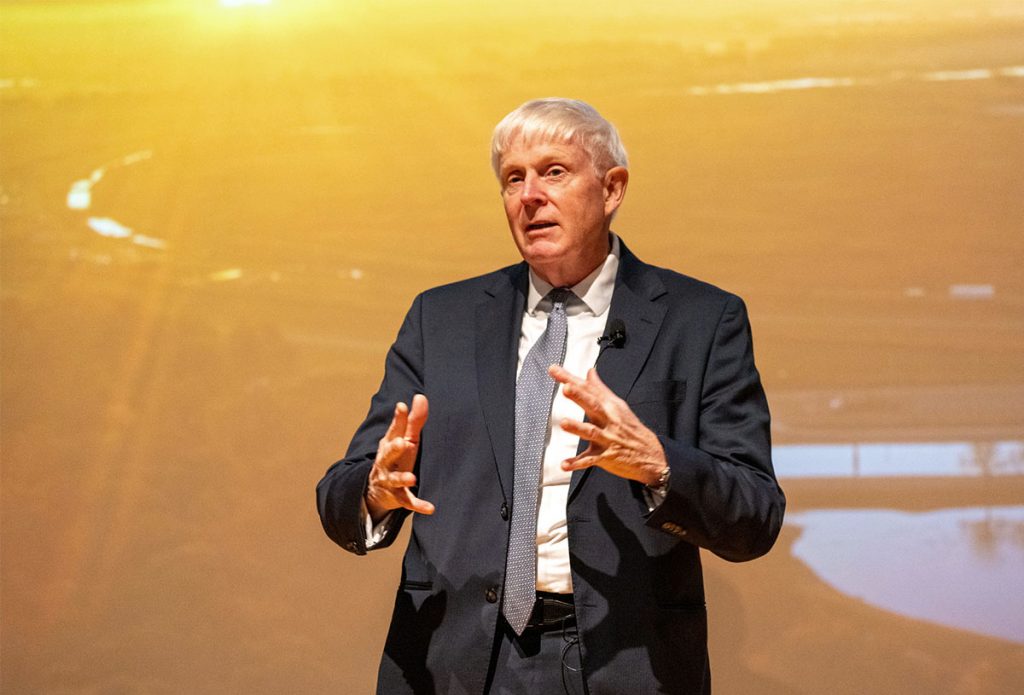
University of Chicago President Paul Alivisatos made the announcement Dec. 15 in his capacity as chair of the board of directors of Fermi Forward Discovery Group, LLC, which operates the laboratory for the U.S. Department of Energy and whose partners include the University of Chicago and the Universities Research Association.
“We’re excited to welcome Norbert, who brings a wealth of scientific and managerial experience to Fermilab,” Alivisatos said. “He will champion Fermilab’s mission of pioneering scientific discovery, help ensure the success of projects critical to the lab’s future and strengthen the relationships necessary for shared achievements and inspire the next generation of researchers.”
Holtkamp has managed large scientific projects throughout his career — experience that will be critical as Fermilab continues to advance the Long-Baseline Neutrino Facility for the Deep Underground Neutrino Experiment (LBNF/DUNE) among other ambitious projects. During his tenure at SLAC, he managed the construction of the Linac Coherent Light Source upgrade (LCLS-II), the world’s most powerful X-ray laser, along with more than $2 billion of on-site construction projects. He previously served as the principal deputy director general for the International Thermonuclear Experimental Reactor (ITER), a multinational organization working to achieve fusion power at power plant scale.
Holtkamp is deeply familiar with Fermilab, having worked there from 1998 to 2001. During that time, he participated in the commissioning of the Main Injector — the lab’s most powerful particle accelerator — and also led a multi-laboratory study on the feasibility of an intense neutrino source based on a muon storage ring.
In his new role, Holtkamp will continue Fermilab’s work to modernize its operations and infrastructure to leverage the capabilities of LBNF/DUNE — the largest experiment in lab history — and other major projects.
“I am deeply honored to have been selected as the next director of Fermilab,” Holtkamp said. “Fermilab has done so much to advance our collective understanding of the fundamentals of our universe. I am committed to ensuring the laboratory remains the neutrino capital of America, and the world, and the safe and successful completion of LBNF/DUNE is key to that goal. I’m excited to rejoin Fermilab at this pivotal moment to guide this project and our other important modernization efforts to prepare the lab for a bright future.”
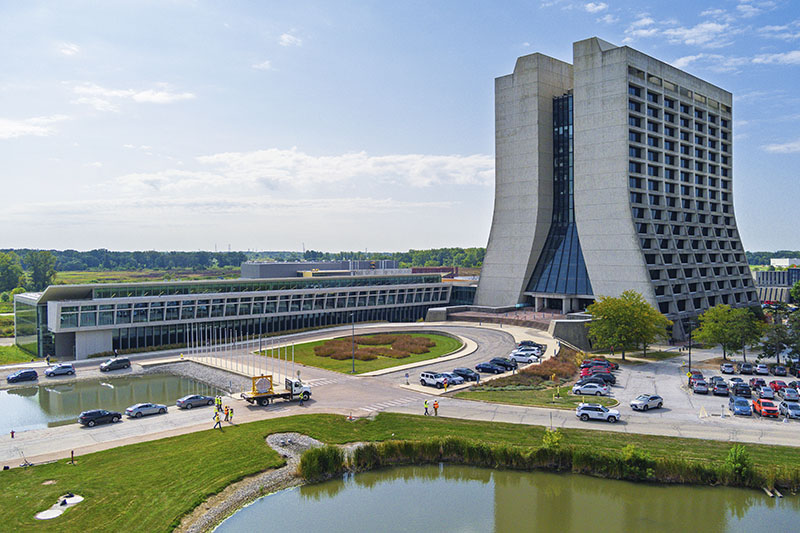
Holtkamp holds the equivalent of a master’s degree in physics from the University of Berlin and a Ph.D. in physics from the Technical University in Darmstadt, Germany.
Holtkamp’s appointment follows an extensive search by a panel of distinguished scientific and organizational experts. The search committee, which included prominent leaders from the laboratory’s critical stakeholders, was chaired by Argonne National Laboratory Director Paul Kearns and Vice-Chair CERN Director-General Designate Mark Thomson.
Holtkamp succeeds University of Chicago Professor Young-Kee Kim, who has served as interim director since January 2025. Alivisatos expressed his gratitude for Kim’s “tireless service” as director.
“We asked Young-Kee to lead the laboratory for one year, and she immediately devoted her talent, leadership and boundless enthusiasm to aid the lab during a time of transition,” Alivisatos said. “Young-Kee played a critical role in strengthening relationships with Fermilab’s leading stakeholders, driving the lab’s modernization efforts, and positioning Fermilab to amplify DOE’s broader goals in areas like quantum science and AI.”
A 6,800-acre facility headquartered in Batavia, Ill., Fermilab aims to shed new light on the understanding of the universe — from the smallest building blocks of matter to the deepest secrets of dark matter and dark energy. Visit Fermilab’s website at www.fnal.gov to learn more.
Fermi National Accelerator Laboratory is America’s premier national laboratory for particle physics and accelerator research. Fermi Forward Discovery Group manages Fermilab for the U.S. Department of Energy Office of Science.
Ten years ago, the first neutrinos interacted in the liquid argon of the MicroBooNE particle detector at the U.S. Department of Energy’s Fermi National Accelerator Laboratory, marking a turning point for the lab’s neutrino research program. MicroBooNE is celebrating its tenth anniversary as part of a vibrant program of liquid-argon-based neutrino experiments, including the Deep Underground Neutrino Experiment — an international collaboration hosted by Fermilab that is on track to becoming the biggest liquid-argon detector ever built and a focal point of particle physics research.
“Liquid argon offered the promise to solve the dual challenges of imaging neutrino interactions with millimeter precision and doing that at the kiloton scale needed to answer big science questions.”
Matthew Toups, Fermilab senior scientist and co-spokesperson of MicroBooNE
In October of 2015, the scientists of the MicroBooNE collaboration were excited about the potential of liquid argon to transform neutrino physics.
“Liquid argon offered the promise to solve the dual challenges of imaging neutrino interactions with millimeter precision and doing that at the kiloton scale needed to answer big science questions,” said Matthew Toups, Fermilab senior scientist and co-spokesperson of MicroBooNE.
Those big questions, the origin of matter in our universe and the unification of forces into a Grand Unified Theory, now lie at the heart of DUNE’s science program. But in 2015, it was not yet clear whether liquid-argon technology was advanced enough to support the future of U.S. neutrino physics research.
“The liquid-argon time projection chamber had been proposed in the 1970s,” said Toups. Projects like ICARUS at Gran Sasso and ArgoNeuT at Fermilab had shown how powerful it could be, but what we wanted to do with MicroBooNE was to show that a large-scale liquid-argon detector could operate for multiple years and deliver a broad physics program.”
The MicroBooNE collaboration achieved this ambitious goal. The detector operated for six years, and the collaboration, to date, has released over 80 scientific publications. More than 70 PhD students have completed their degrees through their work on MicroBooNE, and MicroBooNE’s science output is showing no signs of slowing.
Argon, an inert element, becomes liquid at around minus 303 degrees Fahrenheit. The third most common element in the atmosphere, it is relatively inexpensive to liquify in large amounts, making it ideal for experiments designed to detect neutrino interactions. Inside a liquid-argon-based detector, charged particles from neutrino interactions strip electrons from argon atoms as they pass by, and an electric field draws those electrons to sensing wire planes where the interaction can be recorded and reconstructed in exquisite detail.
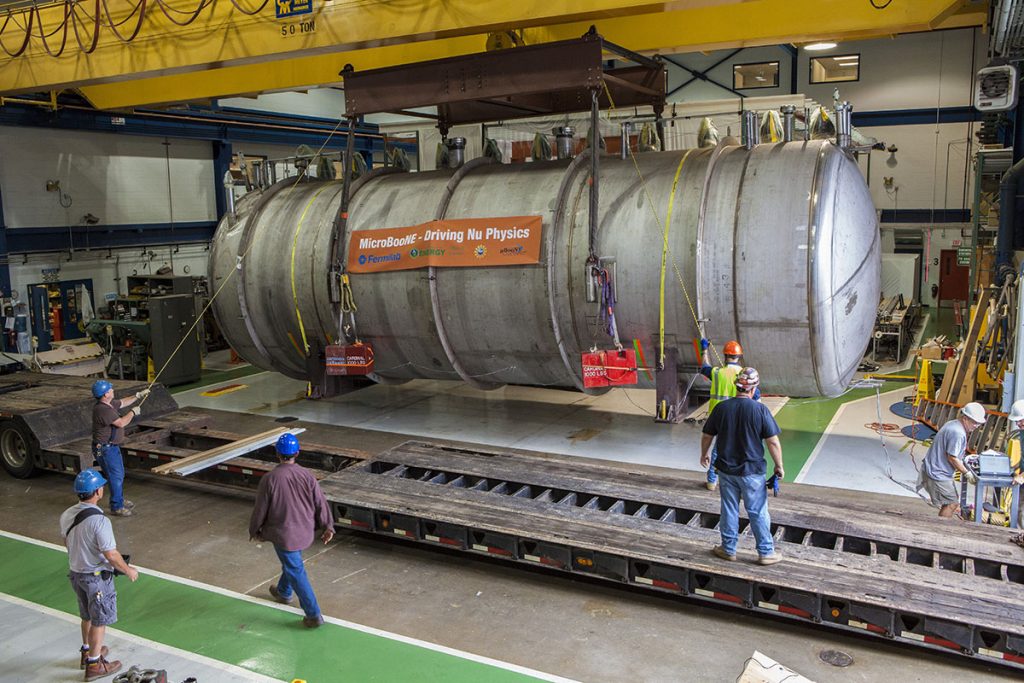
The capability that liquid argon brings to particle identification has enabled MicroBooNE to deliver an impressive program of searches for physics beyond the Standard Model. Foremost is the search for the sterile neutrino — a new type of neutrino that, while completely invisible to detectors, could cause the appearance of electron neutrinos in Fermilab’s Booster Neutrino Beam. MicroBooNE has been able to identify much purer samples of electron neutrinos than previous experiments, placing strong limits on the simplest sterile-neutrino models and guiding neutrino researchers to explore a more expansive, sophisticated range of models to explain the neutrino’s many puzzles. But MicroBooNE’s program of new-physics searches has gone far beyond that, probing phenomena that could reveal new particles or forces in “dark sectors,” which might help explain the dark matter in our universe thought to provide the mass necessary to hold galaxies together.
MicroBooNE has also produced a wealth of new measurements describing how neutrinos interact with nuclei.
“Precision neutrino physics starts with understanding how neutrinos interact with the nuclear target,” said MicroBooNE collaborator Elena Gramellini of the University of Manchester. “Building on the lessons learned from ArgoNeuT, MicroBooNE pioneered techniques to unravel how neutrinos interact with argon’s complex nucleus, producing a remarkable set of measurements that capture the subtle nuclear physics at play. MicroBooNE’s rich set of results is now a treasure trove of data shaping the models that DUNE will rely on to deliver its physics goals.”
Another of MicroBooNE’s contributions to neutrino research is the people who comprise the collaboration.
“The community of pioneering researchers that MicroBooNE has fostered is the foundation of the Fermilab neutrino program.”
Bonnie Fleming, founding MicroBooNE spokesperson and Fermilab chief research officer
“The talent and dedication of the early-career researchers who have made seminal contributions to MicroBooNE’s physics is amazing,” said Bonnie Fleming, founding spokesperson of MicroBooNE and chief research officer at Fermilab. “Many of the current leaders of our field developed their skills as part of MicroBooNE. The community of pioneering researchers that MicroBooNE has fostered is the foundation of the Fermilab neutrino program. We wouldn’t be where we are today had MicroBooNE not demonstrated the power of liquid argon and provided a training ground for so many students and postdocs.”
MicroBooNE is now joined by the Short-Baseline Neutrino Detector and ICARUS experiments that comprise the Fermilab Short-Baseline Neutrino Program. Together, they will open new windows onto the intriguing physics behind nature’s most elusive particle. And the DUNE experiment, poised to take data in only a few years’ time, will use liquid argon to shine light on science’s biggest questions. From those first few interactions recorded in 2015 has grown an international science program, bringing more than 1,000 scientists together to expand the boundaries of human knowledge.
Fermi National Accelerator Laboratory is America’s premier national laboratory for particle physics and accelerator research. Fermi Forward Discovery Group manages Fermilab for the U.S. Department of Energy Office of Science. Visit Fermilab’s website at www.fnal.gov and follow us on social media.
